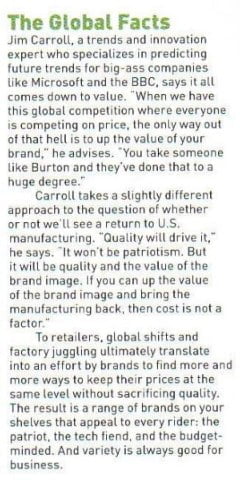“When we have this global competition where everyone is competing on price, the only way out of that hell is to up the value of your brand” — Jim Carroll, Snowboard Trade Magazine, November 2006
“Entities are engaged in survival tactics because they don’t know what to do next” — Jim Carroll
 When I started skiing 7 years ago, I marveled at the different attitudes between skiers and snowboarders.
When I started skiing 7 years ago, I marveled at the different attitudes between skiers and snowboarders.
I think a lot of it is generational; many fellow boomers — skiers, mostly, with the odd exception — will ask me, when we’re going up a ski lift, what I do for a living. If I’m on a lift with a boarder, though, they tend to ask a different question: “What do you like to do?”
That’s a great mindset to have, and I think displays an enthusiasm for opportunity. When it comes to innovation, I think a lot of people don’t know how to innovate because they don’t know what to do next. Why? They’ve spent all their time thinking about cost, and have forgotten about all the other stuff they could be doing!
 In the next few weeks, I’ll be keynoting several events with folks who have been hammered pretty hard by the China/offshoring trend. They know they have to operate differently, and that they need to focus on becoming a low cost operator.
In the next few weeks, I’ll be keynoting several events with folks who have been hammered pretty hard by the China/offshoring trend. They know they have to operate differently, and that they need to focus on becoming a low cost operator.
What they don’t know is what to do next — what do you do after the world is flat?
And what does this have to do with snowboarding and skiing?
Snowboard Trade News has just run an article, “Globalization: Snowboard Nation“, looking at the question, “Does it matter where in the world a brand makes its products?”
I’m quoted in the article, as seen to the right. The magazine also ran my 10 Big Trends That Will Rock Your Worldit can’t be all about cost.
After reading the article this week, and while preparing for the groups that I’m keynoting in the weeks to come, I’ve realized that once people get the ‘flat’ part of this new economy, they are quite mystified as to ‘what comes next?’ And that is where they are missing the point on what innovation is all about. If your world has become flat, and you don’t know what to do next, then put a ripple in it! Change it! Do something different. It’s not just cost that is important — there’s lots more…..
That’s what innovation is all about — taking inertia and turning it into velocity. Given that, this list seems to make sense:
How to put a ripple in your flat world
- Focus on the brand: I emphasized this point in an interview on Danish national TV earlier this summer, where I was talking about the issue of “brand image in a low-cost economy.” The fact is, brand names still matter, if you do the right things at the right time at the right velocity, so that your customers understand that your brand is innovative.
- Go big on quality: I’m on my 3rd DVD recorder. The first two were cheap, Chinese junk, and each lasted only a few months. I went with a brand name, bought the extended warranty, and am quite pleased that I’ve made it to ten months so far. I think quality is suffering in the flat-world, and I think it return to be a defining attribute in the years to come. It’s not all about cost!
- Get religious on “time-to-market” : Hyper-innovation is real — market velocity in every sector is huge as new products are invented and existing products are reinvented. To stay alive, you can’t just pump out low cost junk — you have to get the right stuff to the right market at the right time!
- Go deep with market knowledge: Every market is being devoured by furious innovation. Ask yourself this: can your sales, marketing and other staff keep up? Maybe not : a fascinating survey in the Birmingham Post, in an article about car dealerships, noted that “….35% of sales staff had little confidence in their own ability to demonstrate hi-tech in-car equipment such as BlueTooth devices and voice control systems.” In other words, companies are selling into rapidly changing markets, and yet their sales staff doesn’t have the insight of understanding what it is they are selling. That’s not good.
- Increase value: When I keynoted the Sporting Goods Manufacturing Association last week, I challenged them to look at a baseball bat differently. While they might see a milled piece of wood, I challenged them to think of the baseball bat of 2015. It’s likely to be highly interactive, enabled with intelligence, and will offer the kid of tomorrow some interactive information on their swing training. The company that does that — and links itself to the heightened expectations of the consumer of tomorrow — will have established some type of new value into a traditional, low value, low cost commodity item. Now that’s cool — and that’s innovation.
- Focus on agility: Forget planning — just do. I wrote about agility in my post What makes for corporate agility?, noting that we should “plan for short term longevity: No one can presume that markets, products, customers and assumptions will remain static: everything is changing instantly. Business strategies and activities must increasingly become short term oriented while fulfilling a long term mission.”
- Seek partners: In my book What I Learned From Frogs in Texas, I wrote about the fact that we are entering a world that increasingly involves complexity partnerships. Simply put, in the high-velocity economy, you can’t do everything at the pace demanded of you: you can only do it if you seek out those individuals and companies who possess a unique skill, suitable at this moment for a specific purpose.
- Go upside down: Turn product and service innovation upside down. Look to your customers, suppliers, and just about everyone else for ideas on how to reinvent your products. You just might find that they’ve already redefined your product, and you weren’t even aware of it. Take a look at my other post of last week, about how to turn customers into partners.
- Stay motivated. Folks who have “gone flat” or who “get flat” seem quite dispirited: they have been relentlessly focused on cost, yet there is so much more to the future than becoming a low cost operator. Yet that’s what innovation is all about: doing much more than simply “surviving” into a world that has gone flat, into a world in which you are thriving through innovation.
Going flat is probably the first — and baby step — in adjusting the realities of your structure and innovation culture for the future.




GET IN TOUCH
Jim's Facebook page
You'll find Jim's latest videos on Youtube
Mastodon. What's on Jim's mind? Check his feed!
LinkedIn - reach out to Jim for a professional connection!
Flickr! Get inspired! A massive archive of all of Jim's daily inspirational quotes!
Instagram - the home for Jim's motivational mind!